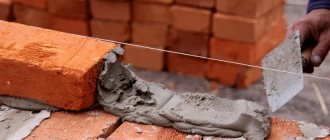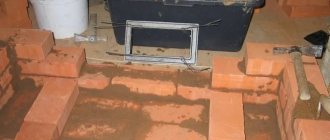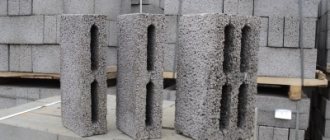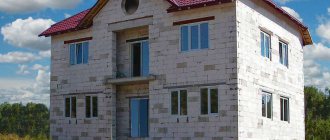Composition and manufacturing process
Sand concrete is a type of structural concrete with a dense structure based on a cement binder and dense fine aggregate.
The composition of the sand concrete mixture ready for production should include only Portland cement, quartz sand and water. Molding takes place in steel molds on a special machine - a vibrating press, where the tamped mixture is regularly shaken to obtain uniformity throughout the entire volume. The blocks are then dried using heat or infrared. The molded products will gain tempering strength for another 28 days under natural conditions, i.e. in a warehouse at room temperature and sufficient ventilation.
Mortar with added clay
To soften the binder component, clay can be used, which is added in approximately the same proportion as lime - 2 or 3 parts per 1 portion of cement.
Clay
The ratio between water and sand is exactly the same as in the previous solution - 4 and 1.5 parts, respectively. The resulting solution is less durable compared to other compositions, but its use is advisable in some cases.
Cement clay mortar
In particular, for the construction of chimneys and stoves, this option is the only one.
Characteristics of sand concrete blocks
A separate GOST has not been developed for sand concrete products, so manufacturers are guided by the following basic standards:
- GOST 6133-99 “Concrete wall stones”
- GOST 13579-78 “Concrete blocks for basement walls”
- GOST 26633-91 “Heavy and fine-grained concrete”
The main indicators characterizing the suitability of any concrete product are strength, rigidity and crack resistance, as well as the ability of the product to maintain the stability of their established values. Sand concrete blocks meet all these requirements.
Their high strength means long service life (75-100 years) and a reduction in the number of repairs, thereby saving the homeowner’s effort and money. Specific values of strength, thermal conductivity and other characteristics depend on the type and design of the block.
Parameters that determine the physical and mechanical properties of sand concrete
- Compressive strength is assigned to the product according to the concrete strength class: from B3.5 to B80 or according to the concrete grade from M75 to M800, but more often M100, M150, M200
- Frost resistance F25-F150
- Waterproof. Grades for this indicator are assigned to concrete, structures from which, according to operating conditions, must have limited permeability or increased density and corrosion resistance: W2, W4, W6, ..., W20
- Average density 1200–2400 kg/m³;
- Thermal conductivity can be improved by reducing concrete density and ambient humidity. At 2400 kg/m³, the thermal conductivity coefficient is 1.51 W/(m °C) under normal temperature and air humidity conditions.
- The concrete surface category is assigned to the product from A1 to A7 according to the area of application and the degree of roughness of the front surfaces.
- Fire resistance The sand concrete block can withstand exposure to direct fire for 7-10 hours.
Types of sand concrete blocks
Sand concrete blocks are classified depending on the area of application (wall or foundation) and location in the masonry.
Wall
- External and internal blocks - for external and internal walls;
- Partition walls - for partitions inside and between rooms.
Fundamental
- FBS - solid
- FBV - hollow (with deep cavities open downwards)
Ordinary or facial
Ordinary blocks assume a position in the masonry in which the surface of the product will not be visible during operation; they require further finishing at the construction site. Front blocks (have one front surface or two - side and end) do not need modification; allow you to obtain a structure that is ready for use immediately after construction (relief, rough, granular, polished, etc.)
Based on their structure, blocks are divided into solid or hollow , i.e., having technological voids of various geometries (cubes, slots, cylinders), through or not through, molded during the manufacturing process.
Masonry mortar for plastering walls
The use of sand and cement is advisable not only in mortars that are suitable for brickwork, but also in finishing work and plastering walls.
In this case, the proportions of all ingredients are also important, so we will consider this issue in more detail. There are various options for ready-made mixtures on sale, in which the recommended proportions are used.
They also use cement as a binder and sand as a filler.
There are mixtures in which sand is replaced with polystyrene granules, sawdust, fine slag, etc.
Sawdust
If you make the solution yourself, then it is very important to adhere to several rules. This is especially true for the quality of sand, because the requirements for plaster mortar are higher in this regard than for masonry:
- the sand must not only be sifted, but also washed. It is very important to get rid of all foreign particles and lumps of clay;
- the coarse sand fraction directly affects the degree of adhesion of the plaster to the surface. In some cases, the use of fatty clay is allowed, but not more than 5% of the total mass. If a larger amount of clay is used, then there is a possibility of small cracks appearing after the plaster dries;
- the use of fine sand is not recommended, because the solution turns out to be superplastic, which impairs adhesion to the wall surface;
- When making the mixture, only dry sand is used . If moisture is present in it, then when mixed with dry cement, the mixture will result in a non-uniform structure.
Mortar for plastering walls
If we talk about the ratio of sand to cement in a mortar suitable for plastering walls, then the brand of the binder component matters here. If M400 cement is used, then one part of it will require 4 parts of sand.
M-400
For one part of M500 cement, one part more filler will be needed. There are no special requirements regarding the amount of water, but it is important to add it gradually. Remember that you need enough water to make the solution look like thick sour cream.
Weight and popular sizes of sand concrete blocks
The weight of blocks with the same volume can be different, which is explained by the presence or absence of voids. So, a 400x200x200 block can weigh 22, 24 or 30 kg. In general, the approximate ranges are as follows: wall blocks weigh from 8 to 40 kg, foundation blocks - from 100 to 2000 kg.
Dimensions of wall blocks, mm:
- length - from 190 to 500
- width - from 90 to 500
- height - from 185 to 300
Dimensions of foundation blocks, mm:
- length - 880, 1180, 2380
- width - 300, 400, 500, 600
- height - 280, 580
Do-it-yourself sawdust concrete production technology
Sawdust concrete is a material widely used in monolithic construction before the advent of foam concrete.
Today, sawdust concrete is most often used to produce wall blocks, which are suitable for the construction of buildings up to 3 floors high. Sawdust concrete block
This article provides instructions following which you can make sawdust concrete with your own hands. We will also consider the purpose of the material, its technical characteristics, advantages and disadvantages.
- Varieties, differences from wood concrete Pros and cons of the material
- Testing sawdust concrete blocks (video)
- Reviews
Advantages
- High strength (and therefore load-bearing capacity) and resistance to external influences allow sand concrete blocks to be actively used in capital construction.
- The presence of voids significantly reduces the weight of the building structure and improves heat and sound insulation properties.
- Ideal moisture resistance: sand concrete practically does not absorb moisture.
- Double-slit blocks are excellent for building cold, non-residential premises, saving related materials and money.
- Environmentally friendly: only natural, non-toxic materials are used for production.
- Favorable price-quality ratio: one cubic meter of hollow sand concrete blocks is approximately 2 times cheaper than a cube of brick of the same design.
Flaws
- Increased thermal conductivity: therefore, when constructing residential premises, it is recommended to insulate walls with a layer of expanded clay concrete blocks, which are not as durable, but much more capable of retaining heat. However, this disadvantage loses its effect if it is necessary to build unheated buildings (garden houses, garages, warehouses, sheds, etc.), fences, extensions, columnar foundations. Thermal conductivity is also not of decisive importance for internal partitions, where strength and sound insulation properties are primary.
- Low vapor permeability: walls made of sand concrete cannot be called “breathable”.
Areas of application of sand concrete blocks
Sand concrete blocks are universal in their application, and therefore they are used to construct residential and public buildings, industrial and auxiliary buildings of industrial and agricultural enterprises; create natural ventilation systems.
Cottages, outbuildings, garages, fences are examples of low-rise housing construction and related equipment using sand concrete blocks. With a wall thickness of 200 mm, it is possible to build high-rise buildings up to 10 floors.
All about cinder block
The main properties include:
- Environmentally friendly.
- Strength.
- Thermal insulation qualities.
- Price.
To what extent are these characteristics inherent in cinder block? Let's try to figure this out, and also consider construction from cinder blocks and all the nuances associated with it.
Product structure close up
Material Definition
Since we decided to use wall stone, I would like to know more precisely what a cinder block is. So, this is a product that is obtained by vibrocompression of a solution based on cement, slag and other mixtures.
The shape is rectangular, the dimensions and percentage of voids are determined by the manufacturer and construction needs.
In addition, we note that the components of the concrete solution can be:
- Granite crushed stone, screening.
- Slag.
- River crushed stone and gravel.
- Sand of any type.
- Expanded clay, wood concrete.
- Break of brick, concrete, glass.
Note! The use of combat allows us to talk about a virtually waste-free production method.
Dimensions
But with the dimensions of the product, as with many building materials, there is an interesting situation.
Different sizes - different tasks
- Firstly, no matter how much you try to find out the single standard size of a cinder block, nothing will work, there is simply no standard! On the other hand, there are fairly common cinder block dimensions of 390x190x190 mm, which, with minor modifications, plus/minus 10 mm can be equated to a certain standard.
- Secondly, the dimensions are always influenced by production, and the manufacturer has the right to choose his own shape.
- Thirdly, there are also half-blocks that are used for the construction of interior partitions.
Product size
And here we come to the fact that there are also types of cinder blocks that are worth mentioning.
- Cinder block sizes: standard values
- Composition of cinder block
Kinds
Conventionally, we can divide all wall stone into two types, but we will still give an example of three standard sizes:
- Solid stone. Durable building material, weighing up to 28 kg.
- Hollow wall block.
- Semi-block. Used for the construction of interior partitions.
What’s interesting is that these types also have their own hollowness; for example, blocks with a hollowness of 30 and 40% are most often produced, and this difference of 10 units significantly changes the basic characteristics of the stone.
That is, we take the same hollow cinder block, but with different hollowness and get a change in thermal insulation performance. Strength at 40% is, of course, lower, but during masonry this moment can be compensated for by correctly used metal embedded parts.
Dimensions and voids of this product
In principle, this is where the difference between types ends. Although if you try to classify according to all sizes of the product, the list of types can turn out to be quite wide.
Walls
We will immediately take the example of a cinder block wall, because using its example we can normally discuss such dimensions as the thickness of the cinder block, which always raises a lot of questions, and go through some other parameters.
First of all, we are interested in whether a wall 190 mm thick, which is the size of a cinder block, can function normally? Plus, what exactly do we mean by functionality?
Let's go through the points:
- Thermal insulation. Even masonry in one block replaces the thickness of a brick wall of 60-80 cm when considering the thermal insulation qualities of the material. Do not forget that we can always choose, for example, a block with a void ratio of 40%, and thus further increase the thermal insulation rate.
- Strength. Here the width of the cinder block practically does not matter; in our case, the strength can reach up to M 200, that is, one square centimeter of the block is ready to withstand up to 200 kg of weight. And a wall of 190 mm will have sufficient strength for a low-rise building.
Masonry
- Frost resistance. Here, we cannot boast of high parameters, however, in any case, we insulate and treat the walls, so low frost resistance is not a problem when choosing a material.
- Soundproofing. This point is also interesting, but not so much in the supporting structure as in the interior partitions. And I must say that the sound insulation rates are very high, which gives us the opportunity to use semi-blocks indoors.
Important! It is worth noting that cinder blocks can be made from completely different types of scrap, and it is not a fact that when purchasing a finished product we are purchasing “healthy” material. It is because of this that some experts consider cinder block construction only in the form of non-residential premises.
Finishing the conversation about the functionality of walls, let's say that the brand of cinder block, starting from M 150, is quite suitable for load-bearing structures, besides, we have solid bodies, and the construction technology itself from cinder block stone does not imply the construction of skyscrapers - a maximum of three floors, which is quite enough for the material.
Full house made of cinder blocks
Principle of masonry
And finally, let's talk about masonry. There are no fundamental differences here from what we encounter when working with simple bricks. But we can note that the dimensions of the product, its length and height allow laying to be carried out much faster.
This point can be especially important for beginners and those who build with their own hands for the first time; working with large-sized products is really easier.
No less interesting is the fact that the consumption of material for a cinder block cannot but rejoice.
- Firstly, if the product has a flat surface, a small amount of glue or cement is initially used on it;
- Secondly, due to the elasticity of the adhesive solution, you can achieve a fairly compact seam, and this also reduces consumption.
Masonry with low material consumption
Approximately, for one square meter of masonry, up to 6 kg of glue can be used in one block, and this is an excellent indicator, plus the price of both the material and the cinder block allows us to speak of a very economical construction option.
Transportation
Since sand concrete blocks of the same size can have different weights, the number of loaded units also varies. So, in a car with a carrying capacity of 20 tons, from 700 to 900 blocks with a volume of 400 × 200 × 200 mm are placed.
The shipment and transportation of the product should begin only after the concrete strength has reached the required value (tempering strength).
At the warehouse site or directly on the production line, the blocks are placed in flat or rack pallets, wrapped in film (shrink or stretch) and tied with steel or polymer tape. The height of the transport package formed in this way should not exceed 1.3 m.
When storing, ready-made transport packages are placed on the loading platform in stacks (in one or two tiers), maintaining a distance between them of at least 0.5 m. Blocks that have blind voids are placed in the package with the voids facing down.











